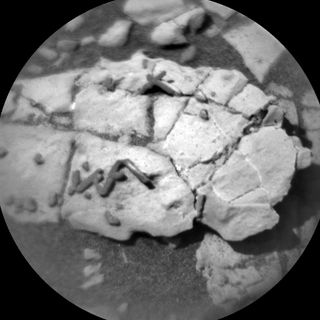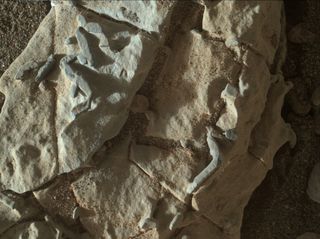
Life Detection on Mars: Are Red Planet Protocols in Place?

Finding evidence for life on Mars has been a decades-long ambition for NASA, which has spent billions of dollars to send machines wheeling over, poking and probing the Red Planet. But once the signs of life are found, how are those findings verified?
In early January, NASA's Curiosity Mars rover came across what some researchers thought might be trace fossils on Mars. Researchers first spotted the eye-catching, tiny, stick-like features in black-and white imagery, but they were compelling and unusual enough for the rover science team to roll the robot back to further interrogate them.
A strictly mineral origin was deemed to be the most plausible. Still, for some, the features suggested bioturbation — a process through which organisms living in sediments can disturb the very structure of those sediments. The oddities looked similar to Ordovician trace fossils here on Earth, which stem from an era more than 440 million years ago. [12 Possible Reasons We Haven't Found Aliens]
Regarding trace fossils on Mars, "We don't rule it out," Ashwin Vasavada of NASA's Jet Propulsion Laboratory in Pasadena, California, and project scientist for the Curiosity Mars rover, told Space.com. "But we certainly won't jump to that as our first interpretation."
The event underscored the degree of difficulty in studying and analyzing such peculiar features, as well as the limits of robotically performed "Curiosity science investigations" (CSI). But it also begs a fundamental question.
No doubt, Mars is holding its secrets tight — but if the ongoing work of detecting life proves positive, what protocols are in place to confirm such a verdict?
Ladder of life
"It has been a long time since we have visited the procedure for extraterrestrial life announcements," said NASA's Michael Meyer, program scientist for the Mars Science Laboratory and lead scientist for the space agency's Mars Exploration Program in Washington, D.C.
Get the Space.com Newsletter
Breaking space news, the latest updates on rocket launches, skywatching events and more!
"My presumption is that the finding and announcement would go up our chain-of-command, more than likely going all the way to the President," Meyer told Space.com in an email. "The perceived rapidity with which the finding would go viral just changes the immediacy of the response. In some ways … not too different from a spacecraft failure."
Jim Green, NASA Planetary Science Division director, said to organize thinking and tackle the topic of direct detection of life elsewhere, NASA and the astrobiology community have crafted what's tagged as the "Ladder of Life Detection." The ladder categorizes features that indicate life, ordered from most to least indicative of life, and how they might be discovered.
Green told Space.com that while life-detection tools have limitations, instruments today are at various rungs on that ladder. "Current systems give us indications that tell us what to do next as we climb up that Ladder of Life," he said.
The ability to make a comprehensive set of measurements to detect life or past life on Mars is a complicated, evolving process, Green said, requiring a systematic approach. "So that's where we are. We've got the methodology, I think, to keep moving in that direction." [Missions to Mars: A Robot Red Planet Invasion History (Infographic)]

Martian meteorites
Everett Gibson, emeritus scientist at the NASA Johnson Space Center in Houston, Texas, was co-leader of the team that announced in 1996 that it had discovered possible signatures of past life in ALH84001, a Martian meteorite that fell to Earth. Several years later, the team said that additional evidence in three more Martian samples bolstered its case.
The claims regarding ALH84001 were hotly debated, with the wider scientific community pointing to non-biological causes of the unusual features detected within the meteorite. The debate over the possible evidence of life in the Mars rock, however, is viewed by many as a key event that helped shape the field of astrobiology. Gibson also found the recent Curiosity photos interesting and is eager to learn the composition of the features imaged. "They remind me of things we have observed throughout the terrestrial geologic record of the Earth … but these features are on Mars," he told Space.com.
"At least the JPL Curiosity team had enough interest to go back and obtain additional data on these features," Gibson said. "Now, if [only] they would do compositional measurements on the features and the matrix from which they reside," he said.
An analysis by Curiosity's Sample Analysis at Mars (SAM) instrument "would also be nice to seek residual biochemical-related compounds which might reside with the features," Gibson said.
While data from SAM would have been nice to have, it was not used to study the curious features on Mars. (SAM is able to study powdered rock and regolith drilling samples.)
"We did not get a chance to sample these interesting features with SAM," said Paul Mahaffy, principal investigator for SAM at NASA's Goddard Space Flight Center. The Curiosity Mars team has been doing troubleshooting work on the rover's drill recently, he told Space.com, which precluded drilling for several months.

Interpretations of data
Regarding the search for life on Mars, Gibson remains confident about his team's ALH84001 meteorite analysis and claims, which are now more than 20 years old.
"We still stand by our 1996 report in Science magazine, and none of our data has been disproven … only interpretations of the data," Gibson said.
"Clearly early on Mars — in its first billion years — conditions were suitable for biogeochemical processes related to living systems to have operated. Now we await further data from Curiosity and the team," Gibson said.
Even if slam-dunk proof of life were to be found on Mars, how would it be announced? And is there any process for double-checking the claims before that momentous announcement? "None that I know of," astrobiologist John Rummel, a senior scientist with the SETI Institute and former head of NASA's Planetary Protection Office, told Space.com.
"I would anticipate that the smart thing to do would be to review the evidence, in private, with a panel of experts who have an understanding of the evidence being examined, and then move to the appropriate place from there," Rummel said.
That expert group, Rummel said, would have to wrestle with some key questions, such as: What other evidence would be used to corroborate such a finding? What are the possible false-positive indicators that might be leading us to mis-identify the evidence we are seeing? [How NASA Could Look for Ancient Life on Mars (Infographic)]
Reaffirm the interpretation
Rummel recalls that with ALH84001, multiple investigators were able to examine the meteorite itself, as well as provide expertise related to the evidence gathered by the NASA Johnson Space Center team.
"I would say, if one is faced with tantalizing evidence of a possible 'find' of ancient life on Mars," Rummel said, "one's first consideration would be to reaffirm the interpretation of the evidence already gained, and to conduct other tests that might support or refute that interpretation."
If one sees morphological evidence — evidence based on structures found on Mars — Rummel said that chemical analyses should then be performed to see if the results are consistent with the interpretation of the morphology. "Verification of the data in as many different ways as possible is good," he said.
That idea is shared by Bruce Jakosky, professor of geological sciences and associate director for science at the University of Colorado's Laboratory for Atmospheric and Space Physics. He is also principal investigator for the MAVEN mission now orbiting Mars.
Jakosky said that Curiosity's most recent find is very different from the ALH84001 situation.
"In the case of ALH84001, the original researchers did a tremendous amount of analysis before going public, to define the characteristics of what they were seeing and to compare them against multiple different hypotheses of how they might form," Jakosky told Space.com. "They put forward their best hypothesis, discussed why both biological and nonbiological mechanisms for formation might be possible, and reached their best conclusion. They recognized the uncertainties in their conclusion as well," he said.

Horribly premature
In the case of Curiosity finding odd features, "all we have so far is a single set of images, with no additional in-situ analysis of what is present and no thorough comparison against competing hypotheses," Jakosky said.
Speculation as to whether these features could be biological "is horribly premature," Jakosky said. "While it may be that a biological origin is possible, science is about determining what is most probably and not just what is possible."
If something is eventually found that turns out to be biological, Jakosky suspects that such a conclusion would not be presented in a grand press conference where the discoverers announce that life has been found.
"The more likely scenario is that it will take multiple analyses by different investigators, and that a consensus will be built up over time as non-biological scenarios are either ruled out or deemed to be less likely," Jakosky concluded.
Leonard David is author of "Mars: Our Future on the Red Planet," published by National Geographic. The book is a companion to the National Geographic Channel series "Mars." A longtime writer for Space.com, David has been reporting on the space industry for more than five decades. Follow us @Spacedotcom, Facebook and Google+. This version of this story was posted on Space.com.
Join our Space Forums to keep talking space on the latest missions, night sky and more! And if you have a news tip, correction or comment, let us know at: community@space.com.

Leonard David is an award-winning space journalist who has been reporting on space activities for more than 50 years. Currently writing as Space.com's Space Insider Columnist among his other projects, Leonard has authored numerous books on space exploration, Mars missions and more, with his latest being "Moon Rush: The New Space Race" published in 2019 by National Geographic. He also wrote "Mars: Our Future on the Red Planet" released in 2016 by National Geographic. Leonard has served as a correspondent for SpaceNews, Scientific American and Aerospace America for the AIAA. He was received many awards, including the first Ordway Award for Sustained Excellence in Spaceflight History in 2015 at the AAS Wernher von Braun Memorial Symposium. You can find out Leonard's latest project at his website and on Twitter.
